- Login or Register
No account yet? Sign up


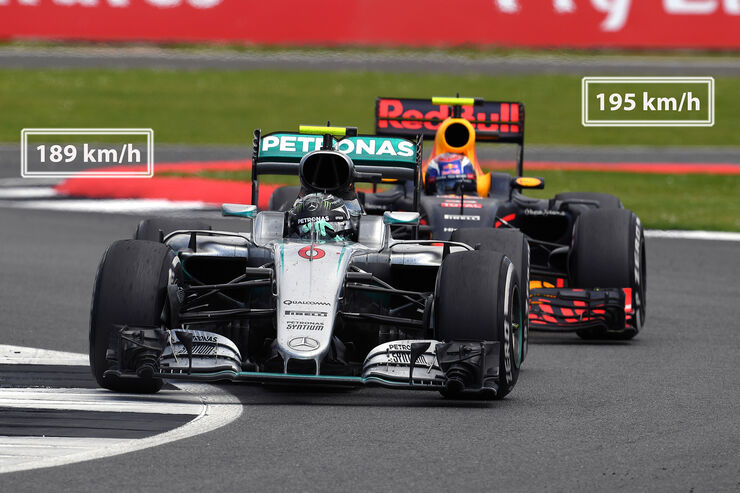

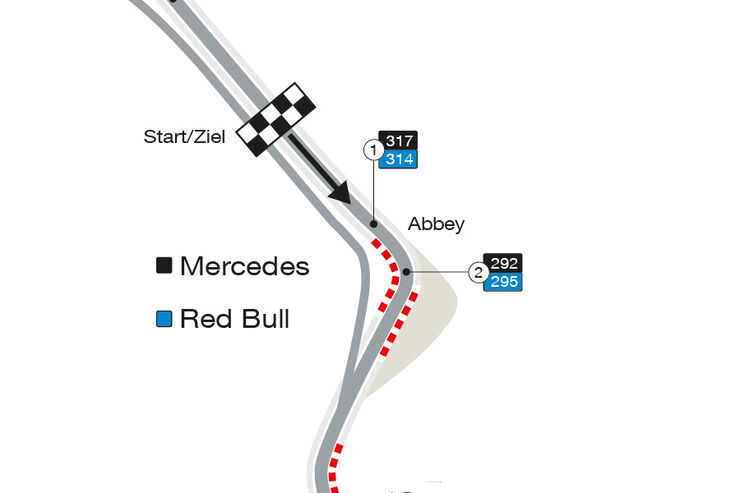
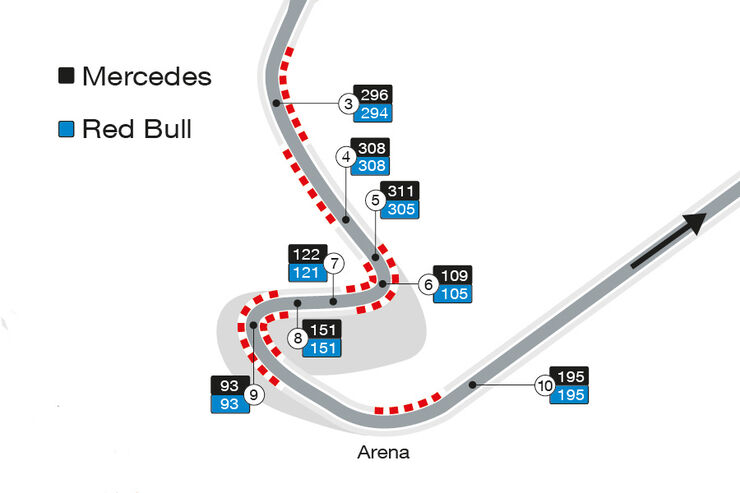
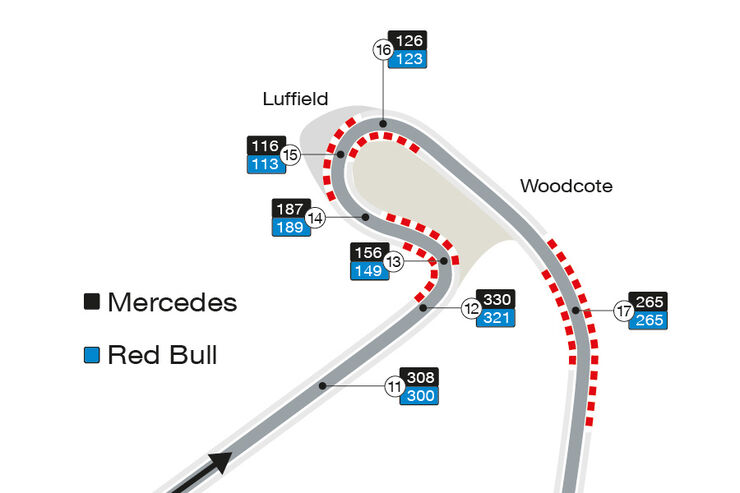
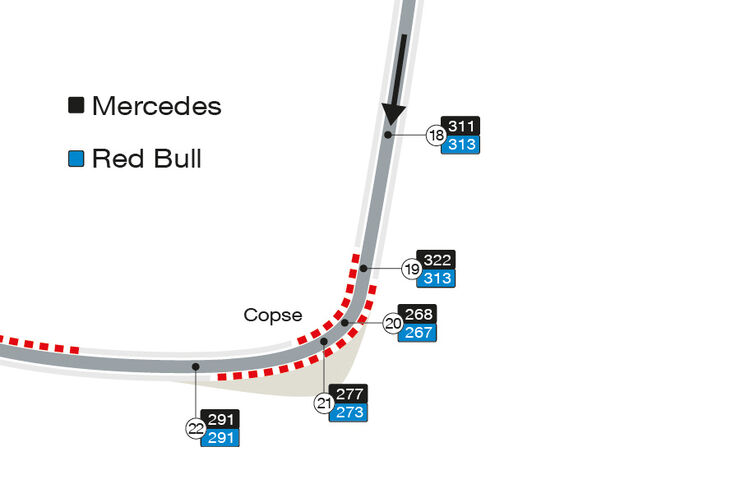
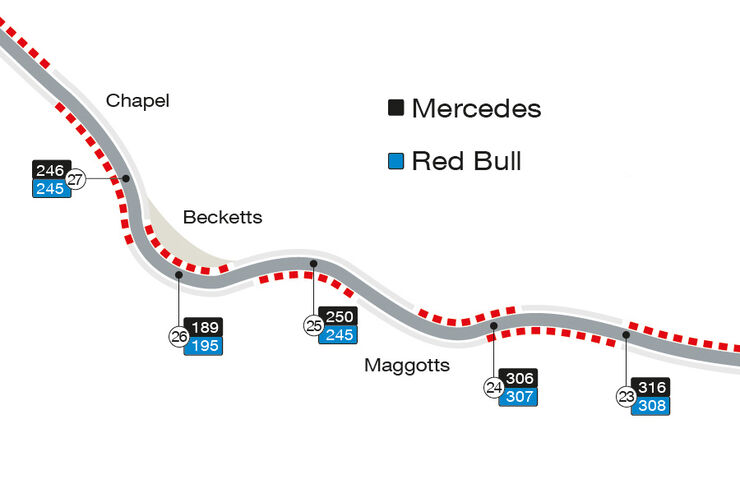

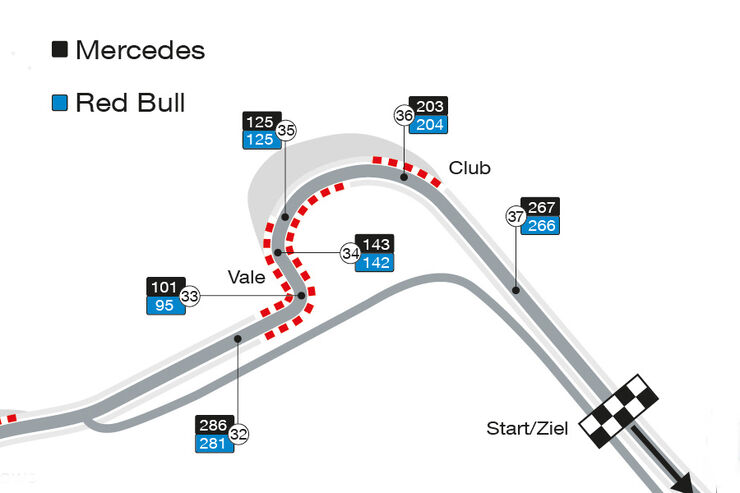
Normally Formula 1 fans get only the lap times, the 3 sectors-Optima and 4-speed measurements from the official timing to face. In the sector times and speed values but remains open, in which round they scored. It always involves the best value of the respective driver in qualifying and in the race.
This is of limited significance, because the data can be determined in different rounds. To find out where which car wins time and lose, you would have to set the fastest laps and speed values above the other in the round. Since only help GPS data. So you can compare the speeds directly and get an idea of the characteristics of the individual cars.
GPS data from Silverstone and Budapest
Auto Motor und Sport has expressed concern GPS data from Silverstone and Budapest. We were interested in the comparison of the best second best. So Mercedes against Red Bull. And on 2 routes on which the influence of the engine is relatively low. But still counts as our GPS analysis shows. So we can check for the first time, how much truth behind the allegations of Red Bull Video: plugged formula Schmidt Azerbaijan, Mercedes win only thanks to the engine advantage.
The GPS data are wild Charts, which are meant for balancing each other. The X-axis shows the way. In Silverstone are the 5,891 meters for a round. The round at the Hungaroring measures 4,381 meters. On the Y-axis of the speed in km / h is indicated. In Silverstone we move 93-327 km / h at the Hungaroring 79-331 km / h.
Under the zero line, the time delta is indicated in seconds in relation to the distance traveled. The graph shows where the slower vehicle time wins and loses. In the where the temperature curve pointing upward sections, makes the Mercedes Video: Formula Schmidt Azerbaijan lost ground. The other way around will bring the Red Bull on. The final value is the difference in lap time.
Mercedes wins in the second part of the line
Let's start with Silverstone. is compared the pole position lap by Lewis Hamilton with 1.29,287 minutes. is your relation to the faster of the two Red Bull, in this case, the round of Max Verstappen with 1.30,313 minutes. The time projection of the Mercedes was blatantly at Silverstone with 1.026 seconds.
In our GPS comparison round of Mercedes accelerates until the end of the final straight to 317 km / h. The Red Bull comes with 314 km / h near amazing. The image can also be seen in the next full throttle passage. Before braking point for Village curve of Mercedes wins with 311: 308 km / h just barely. On the following lines, the picture attracts more and more apart in favor of Mercedes.
Up to half of the Wellington straight or the Hangar straight the Red Bull can keep up. Then the Mercedes wins partly solid at speed. 9 km / h in the section Wellington, 6 km / h on the Hangar Straight, 5 km / h before Vale. This has 2 reasons: The air resistance of the Red Bull is greater because of the increased angle of attack. And the Renault V6 turbo no longer provides the back as much electric power.
When accelerating both cars are on par practically. This speaks for a good traction when W07 and RB12, but also have steam of the Renault engine at low speeds. Between curves Farm and Village of Mercedes is just 1 km / h faster.
In the Aintree-left turn into the Wellington straight into creating both 195 km / h. On the short walk between Brooklands Luffield wins the Red Bull even 2 km / h. And in Woodcote, both with 265 km / h again at the same speed. Same game exit of Vale where Mercedes by 1 km / h better and at the apex of Club Corner, with 204: go 203 km / h at Red Bull. The target curve is already full in the acceleration zone.
In 4 curves Red Bull is faster
Also interesting are the curves. In 4 corners Red Bull is faster. Abbey, Maggotts, Becketts and Club. While the difference in Club (204 km / h 203 km / h) and Maggots (307 km / h 306 km / h) extremely tight turns, Red Bull wins the comparison in Abbey 295 km / h 292 km / h and in Becket even at 6 km / h 195 km / h 189 km / h.
Stowe Corner prevails in the apex of the curve with 220 km / h tie. Hamilton but deflected by 5 km / h faster than a Verstappen. The Farm Curve comes with 296 km / h 294 km / h Mercedes, just Copse Corner with 268 km / h 267 km / h, Chapel with 246 km / h 245 km / h. The image in fast corners is therefore not uniform. The bottom line both cars are in these curves probably equivalent. The difference is the driver.
Mercedes gets time in the slow corners
A very different picture of the balance of the slow corners. The walk through the Bank of Mercedes, in some cases quite significantly. And that is also responsible for the large time difference. Because you spend in slow corners more time than in fast.
Here the distances in detail. Mercedes wins Village Corner with 109 km / h 105 km / h, Brooklands 156 km / h 149 km / h, Luffield 116 km / h 113 km / h and Vale at 101 km / h by 95 km / h , Only in The Loop the Red Bull is the Mercedes with 93 km / h equal. The superiority in the slow passages several reasons again. One is hidden in the drive. The Mercedes V6 turbo drives like a street engine. No other engine depends as much on gas.
But the Mercedes W07 also benefits the chassis, weight distribution and center of gravity. Here Red Bull punishes again the angle of 1.9 degrees. In comparison, the Mercedes rises rearwardly at only 1.0 degrees. In contrast is the shorter by 68 millimeter wheelbase of RB12. This gives a touch more agility. That Red Bull may have to manipulate in the weight distribution, shows the recent engagement of front wing and nose. There two kilograms were saved.
Hungaroring confirmed Silverstone
The readings at the Hungaroring confirm basically what we have learned in Silverstone. There, however, the Red Bull values we have been lost in the region of 1700-2200 meters. This includes the curves 4 and 5. The projection of Mercedes on Red Bull was smaller with 0.315 seconds not only because of the lower length of the route. The route profile better suited to Red Bull. There are lots of Fifth Gear corners like Becketts, where Red Bull at Silverstone had sovereignty.
Nico Rosberg fastest practice lap of 1.19,965 minutes was not optimal by the famous lob in curve. 8 The German gave there because of the yellow flags 0.12 seconds ago. But Daniel Ricciardo said afterward, he could have gone faster than the 1.20,280 minute round.
The top speed is officially measured 300 meters behind the finish line. In fact, the cars are just 200 meters later much faster way. Rosberg at 331 km / h Ricciardo 323 km / h. We have already observed in Silverstone. Output of the target curve extend both graphs parallel. At the finish line the Difference 3 km / h 200 meters then 8. km / h.
Even more extreme is the exit of Turn 3 on the short straight, rush through the both cars with 208 km / h. 80 meters later it stands at 237 km / h 237 km / h is still undecided. Then the Mercedes turns on the afterburners. Shortly before the braking point for turn 4 he wins with 305 km / h 293 km / h.
The difference could therefore be as crass as Ricciardo before something goes off the accelerator in order to bring in the car for 210 km / h curve is not too much trouble. It was one of two curves, in which the FIA has monitored the barriers per sensor. Apparently wanted Ricciardo remain in the first attempt in Q3 on the safe side. Rosberg other hand had to go full risk shortly before the finish.
Let's take a look at the 300 meters straight between the curves 11 and 12. Again, the Red Bull on the first 100 meters keep up. Both drivers reach 226 km / h. Before braking point at Turn 12 Rosberg is however measured 292 km / h Ricciardo only 284 km / h.
Up Curve 3 Ricciardo is in the lead
In the corners of the comparison with a slight advantage in favor of Red Bull goes out. Red Bull wins in the 180 degree turns that are taken in third and fourth gear. So the penultimate curve at 108 km / h 107 km / h and the last with 133 km / h 127 km / h. In the first turn Ricciardo is 10 km / h faster. Since Rosberg has probably missed his braking point, which explains its projection of only 0.039 seconds in the first sector.
The curve 8 and 9 go because of the yellow flag to Ricciardo. Rosberg took 30 meters long foot off the gas. On the other hand Ricciardo had not so much grip on the track at the time of his round. He went right at the beginning of Q3.
The second curve belongs Rosberg. He's there at 3 km / h faster than Ricciardo. In curve 10 Rosberg has 235 km / h 233 km / h in the lead. While both drivers reach the exact same speed of 208 km / h in curve 11, Ricciardo makes in curve 12 clearly lost ground. He's there at 5 km / h faster than his Mercedes rival.
During the course of the term delta can be seen that Ricciardo to curve 3 is even the lead. Shortly before the chicane be residue amounts to almost half a second. Some of it he makes the curve maze then made up for it. In the last 300 meters to the finish line, the curve is virtually flat. The GPS comparison at Hungaroring shows how the ideal route for Red Bull takes a look. A series of medium-speed corners without a straight line between them.
At this point I started laughing, "The rub comes from being able to find a speed threshold whereby you’re effectively switching off the rear wing. This happens when the car's rake is reduced: as the load builds with speed, the car is forced toward the ground, which in-turn rotates the wing and overloads it, stalling flow, both reducing downforce and drag."lio007 wrote:Nice analysis on the RB12:
http://www.motorsport.com/f1/news/tech- ... 06747/?s=1
You seem to be making a lot of guarantess with no supporting evidence. You can't claim that putting a batwing from another car onto another wont work. That is a bit overreaching given your lack of data.turbof1 wrote: But the batwing is not the same for Red Bull and Mercedes. Far from it infact. Red Bull for instance uses a lift-inducing winglet above the splitter, while Mercedes uses a more neutral winglet a bit higher up.
Again it's not Lego: you can't just take a Mercedes piece and put it on the Red Bull. That piece has to be molded and finetuned first, with hundreds of hours of cfd and windtunnel put in. I can guarantee you if you'd use a full on copy of the batwing from the Mercedes on the Red Bull, you'd instantly loose performance on the Red Bull.
Batwings are not general shapes. They are highly specific. Underchassis turning vanes generally are general shapes. However, ever since 2009 these have been highly finetuned up to a point where you are deep into diminishing returns. I'll go one further: there is not a single solution out there in the field anymore that would be a slap-on-instant-improvement. New solutions require adaptation of surrounding parts as well before you'd extract a surplus of performance out of it.
So the same for the bargeboards. Mercedes and Red Bull have different philosophies starting at the front of the car:
https://s31.postimg.org/v6vw2oz63/merc_vs_rbr.png
You can't make Mercedes bargeboards work correctly if your nose, front wing, underchassis turning vanes, suspension, splitter, floor,... aren't properly adapted as well. I just listed up half of the car requiring to change in order to integrate one new concept. That's great perhaps if you are building a new car for next season, but during the season you simply do not have time nor resources to do this.
Same goes for you my friend. You have not put one single thing forward that makes literal copy paste a viable option in current F1. But you want emperical proof that copy paste does not work that simple? I think these 2 images say all:Ringo wrote:You seem to be making a lot of guarantess with no supporting evidence. You can't claim that putting a batwing from another car onto another wont work. That is a bit overreaching given your lack of data.


Ringo wrote:Aero is sensitive yes indeed, however you can place a general shape in a specific area, for example a batwing, and see an improvement as the formula1 cars all do the same thing aerodynamically. You then fine tune that change to suit your car.
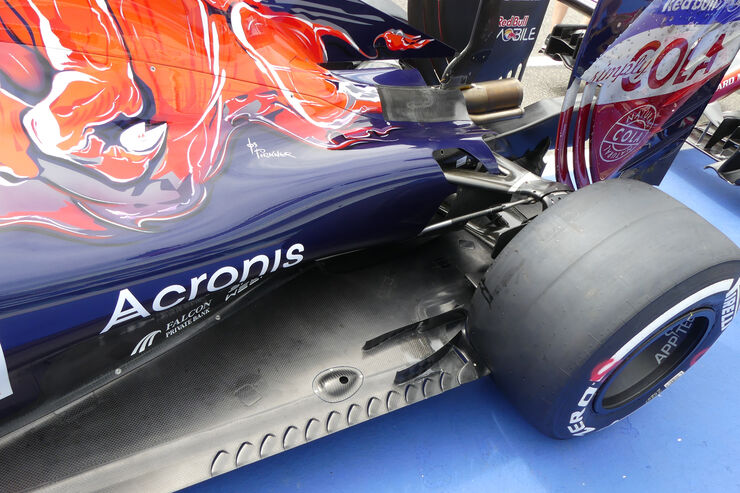

Aside from specific flow conditioning needs, mind I also want to point to the drag footprint: essentially engine power determines how much lift/drag ratio can be sacrificied for outright more lift. Red Bull has less engine power, meaning they can't run as much drag as Mercedes. Even if these 2 cars were aerodynamically identical, the forked floor of Mercedes can still end up as a worse solution for Red Bull due less engine power, compared to a conventional solution. And it's not unreasonable to assume the forked floor generates more drag.ringo wrote:I'm surprised that no one has copied the multi element barge boards on the merc as yet.
maybe we could see it on the redbull after the break?
Except it was not. What I have shown is a 12 month gap between having coanda and having no coanda! Williams tried out several iterations of the coanda exhaust, but they could not get it right. In the end, they reverted to a none-coanda exhaust which actually worked better for them and made them faster. They could not get it to work for their car. This reinforces my point that no solution is a bolt on improvement.As i said, they function the same way, in the same areas on the car; be it 20 or 10 slots on the floor. The point is the slots were copied and the coanda was copied and the cars were faster (and you show almost a 12 month gap between the designs anyway).
Not even half the field dabbed into that, with the other half struggling to get it to bring benefits. Several tech journalists mentioned this has to be integrated to airflow stream of the front wing.Blown wheel nuts
That's extremely vague, with the applied solutions varying wildly from to team.high detail rear wing endplates
I highly doubt that given the amount of changes on us. Especially given the rules on bargeboards are changing. I'll even bet you Mercedes is not going to use its comb solution next year.and could also mean the difference between first and second place in 2017.
I personally like this one more:turbof1 wrote: - Examples of teams failed copy attempts
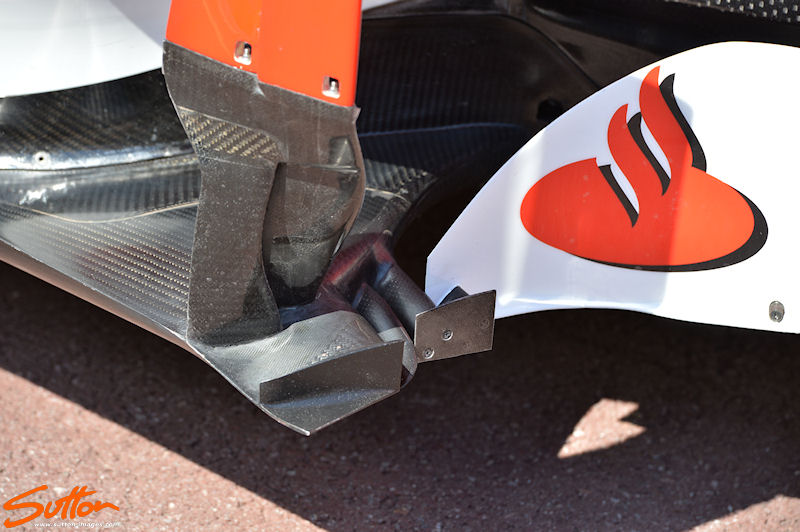
NYGIANTS wrote:Good Read: http://www.motorsport.com/f1/news/tech- ... nt-806747/
You should call Red Bull up and tell them they have no idea what they are doing when it comes to Aero.trinidefender wrote:At this point I started laughing, "The rub comes from being able to find a speed threshold whereby you’re effectively switching off the rear wing. This happens when the car's rake is reduced: as the load builds with speed, the car is forced toward the ground, which in-turn rotates the wing and overloads it, stalling flow, both reducing downforce and drag."lio007 wrote:Nice analysis on the RB12:
http://www.motorsport.com/f1/news/tech- ... 06747/?s=1
Reducing rake actually reduces angle of attack on the rear wing very slightly and will moves the wing even further away from the stall region of its profile.
He's not saying Red Bull messed up; the point you missed out on is that Matt Somerfield has the wrong impression here, which I agree with Trinidefender.SR71 wrote:You should call Red Bull up and tell them they have no idea what they are doing when it comes to Aero.trinidefender wrote:At this point I started laughing, "The rub comes from being able to find a speed threshold whereby you’re effectively switching off the rear wing. This happens when the car's rake is reduced: as the load builds with speed, the car is forced toward the ground, which in-turn rotates the wing and overloads it, stalling flow, both reducing downforce and drag."lio007 wrote:Nice analysis on the RB12:
http://www.motorsport.com/f1/news/tech- ... 06747/?s=1
Reducing rake actually reduces angle of attack on the rear wing very slightly and will moves the wing even further away from the stall region of its profile.
Also, just ignore the bold text because it has nothing to do with anything.
Uhm, except drag is added here. Running more into ground effect will increase your underwing vortex, increasing drag. It is more efficient, yes, but you are still creating additional drag.Furthermore, the nose-down attitude of the car puts the front wing further into ground effect, improving not only its performance but the components downstream, as downforce is increased but not to the detriment of additional drag.